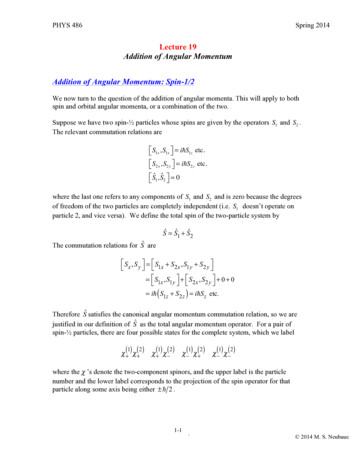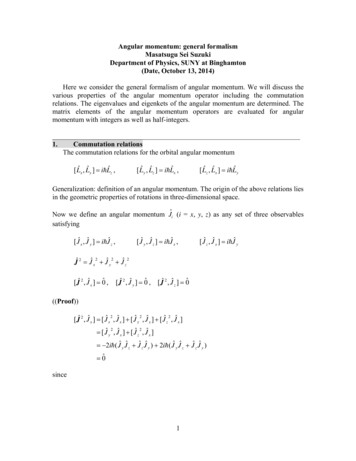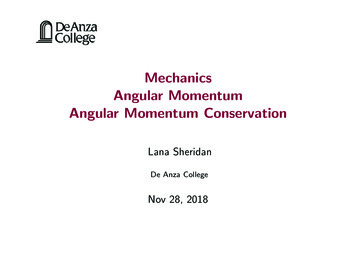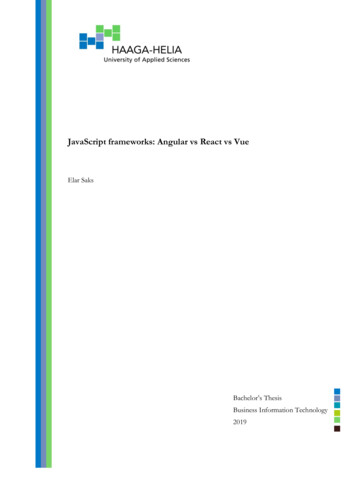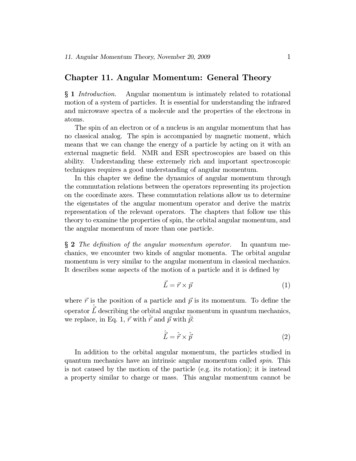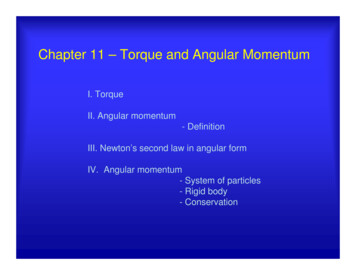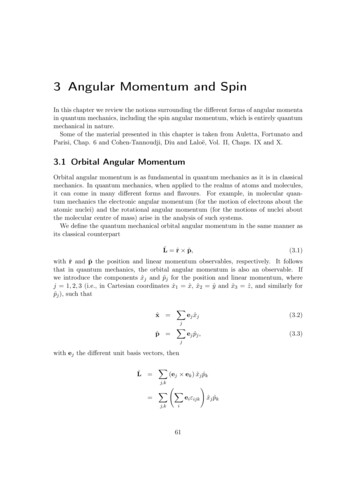
Transcription
3 Angular Momentum and SpinIn this chapter we review the notions surrounding the different forms of angular momentain quantum mechanics, including the spin angular momentum, which is entirely quantummechanical in nature.Some of the material presented in this chapter is taken from Auletta, Fortunato andParisi, Chap. 6 and Cohen-Tannoudji, Diu and Laloë, Vol. II, Chaps. IX and X.3.1 Orbital Angular MomentumOrbital angular momentum is as fundamental in quantum mechanics as it is in classicalmechanics. In quantum mechanics, when applied to the realms of atoms and molecules,it can come in many different forms and flavours. For example, in molecular quantum mechanics the electronic angular momentum (for the motion of electrons about theatomic nuclei) and the rotational angular momentum (for the motions of nuclei aboutthe molecular centre of mass) arise in the analysis of such systems.We define the quantum mechanical orbital angular momentum in the same manner asits classical counterpartL̂ r̂ p̂,(3.1)with r̂ and p̂ the position and linear momentum observables, respectively. It followsthat in quantum mechanics, the orbital angular momentum is also an observable. Ifwe introduce the components x̂j and p̂j for the position and linear momentum, wherej 1, 2, 3 (i.e., in Cartesian coordinates x̂1 x̂, x̂2 ŷ and x̂3 ẑ, and similarly forp̂j ), such thatx̂ Xej x̂j(3.2)ej p̂j ,(3.3)jp̂ Xjwith ej the different unit basis vectors, thenL̂ X(ej ek ) x̂j p̂kj,k! X Xj,ki61ei εijkx̂j p̂k
3 Angular Momentum and SpinX ei εijk x̂j p̂k .(3.4)i,j,kIn equation (3.4) we have introduced the elements of the very important Levi-Civitatensor εijk , which are defined as follows 1 , even permutation of ijk (123, 231, 312) 1 , odd permutation of ijk (213, 132, 321)(3.5)εijk 0 , if i j, j k or j k.This tensor is particularlyuseful for expressing the elements of a vectorial cross-productP(i.e., (a b)i j,k εijk aj bk ), and it is also related to the Kronecker delta (and thusthe scalar product) throughXεijk εimn δjm δkn δjn δkm .(3.6)iIt is straightforward through equation (3.6) to verify that [a (b c)]j (a · c) bj (a · b) cj .Coming back to equation (3.4), since it is also the case thatL̂ Xei L̂i ,(3.7)εijk x̂j p̂k .(3.8)iit then follows thatL̂i Xj,kThere are several important and useful commutation relations involving the (orbital)angular momentum, we derive some here. First, the commutations with the position andlinear momentum componentshiXx̂j , L̂k εkmn [x̂j , x̂m p̂n ]m,n Xεkmn (x̂m [x̂j , p̂n ] [x̂j , x̂m ] p̂n )m,n i Xεkmn x̂m δjnm,n i Xεjkm x̂m ,mand62(3.9)
3 Angular Momentum and Spinhp̂j , L̂ki Xεkmn [p̂j , x̂m p̂n ]m,n Xεkmn (x̂m [p̂j , p̂n ] [p̂j , x̂m ] p̂n )m,n i Xεkmn p̂n δjmm,n i Xεjkn p̂n(3.10)nwhere [x̂j , p̂k ] i δjk was used for both derivations. For the commutation betweencomponents of the angular momentumhL̂j , L̂ki Xh Xεjmn x̂m p̂n , L̂kim,n hi hi εjmn x̂m p̂n , L̂k x̂m , L̂k p̂nm,n i Xεjmn (x̂m εnkr p̂r εmkr x̂r p̂n )m,n,r i X( εnjm εnrk x̂m p̂r εmnj εmkr x̂r p̂n )m,n,r"# i X(δjr δmk δjk δmr ) x̂m p̂r m,rX(δnk δjr δnr δjk ) x̂r p̂nn,r! i Xδjr δmk x̂m p̂r m,r i XXδnk δjr x̂r p̂nn,r(δjr δkn δjn δkr ) x̂r p̂nn,r i X i Xεijk εirn x̂r p̂nn,rεijk L̂i ,(3.11)iwhere equations (3.6) and (3.9)-(3.10) were used. Considering the square of the angularmomentumhiiXhL̂2 , L̂j L̂k L̂k , L̂jk X hi hi L̂k L̂k , L̂j L̂k , L̂j L̂kk63
3 Angular Momentum and Spin εikj L̂k L̂i L̂i L̂k i X i X i Xi,kεikj L̂k L̂i εkij L̂k L̂i i,k εikj L̂k L̂i L̂k L̂ii,k 0̂.(3.12)andiihXhL̂k L̂k , x̂jL̂2 , x̂j k X hi hi L̂k L̂k , x̂j L̂k , x̂j L̂kk i X i XL̂k εijk x̂i εijk x̂i L̂k i,ki hεijk 2x̂i L̂k x̂i , L̂ki,k! X22i εijk x̂k L̂i εijk εikm x̂mmi,k 2 i X Xεjki x̂k L̂i 2 x̂j (3.13)i,ksincePk,i εijk εikm P(δjk δkm δjm δkk ) 2δjm , while similarly hiXL̂2 , p̂j 2 i εjki p̂k L̂i 2 p̂j ,k(3.14)i,kA little more work will establish that (see the Second Problem List)"#ihX L̂2 , x̂j x̂k 2 i (x̂j εkmn x̂k εjmn ) x̂m L̂n 2 x̂2 δjk 3x̂j x̂k(3.15)m,nh2L̂ , p̂j p̂ki" 2 i #X2(p̂j εkmn p̂k εjmn ) p̂m L̂n 2p̂ δjk 3p̂j p̂k , (3.16)m,nhihiwhich also imply that L̂2 , x̂2 L̂2 , p̂2 0. Finally, we find using equations (3.9)(3.10)64
3 Angular Momentum and SpinihL̂j , x̂2 0hiL̂j , p̂2 0.(3.17)(3.18)3.2 Eigenvalues of the Angular MomentumThe fact that the three components of the angular momentum L̂x , L̂y , L̂z commutewith its square L̂2 , from equation (3.12), implies that we can find a common set ofeigenvectors { ψi} for L̂2 and one component of L̂ (the three components cannot sharethe same eigenvectors since they do not commute with each other; see equation (3.11)).This can be verified as follows. If a is an eigenvector of L̂2 and ψi one of its eigenvector,then L̂2 L̂j ψi L̂j L̂2 ψi aL̂j ψi(3.19)implies that the ket L̂j ψi is also a eigenvector of L̂2 . If this eigenvalue is non-degenerate,then L̂j ψi b ψi, with b a constant, and ψi is also an eigenvector of L̂j (and b itscorresponding eigenvalue). Similarly, we can assert that L̂2 ψi is an eigenvector of L̂jby swapping the order of the two operators in the first line of equation (3.19); they,therefore, sharethe same set of eigenvectors. It is common to choose L̂j L̂z and we denote by l2 , m for the set of eigenvectors, with l2 and m the quantum numbersassociated to L̂2 and Lˆz , respectively. As a matter of fact, we set l2 2 as an eigenvalueof L̂2 and m one for L̂z (although both l2 and m still need to be determined).We now introduce the raising and lowering operatorsL̂ L̂x iL̂y(3.20)for which the following commutation relations can easily be establishedhL̂z , L̂ ihihiL̂z , L̂x i L̂z , L̂y i L̂y iL̂x L̂ hiL̂2 , L̂ 0,(3.21)(3.22)from equations (3.11) and (3.13). Using equation (3.21) we can calculate thatL̂z L̂ l2 , m L̂ L̂z L̂ l2 , m (m 1) L̂ l2 , m65(3.23)
3 Angular Momentum and Spinwhich implies that whenever L̂ acts on a eigenvector it transforms it to another eigenvector of eigenvalue (m 1) for L̂z . It is therefore apparent that L̂ are laddersoperators that will allow us to span the whole set of eigenvectors associated to a giveneigenvalue l2 2 (i.e., since L̂ commutes with L̂2 it shares the same eigenvectors). Moreover, we deduce that m must have lower and upper bounds, since the following relationmust be obeyedm l2 2 .(3.24)If we denote the upper and lower bounds of m as m and m , respectively, then wecan writeL̂ l2 , m 0.(3.25)Furthermore, we haveL̂ L̂ l2 , m i hl2 , m L̂2x L̂2y i L̂x , L̂y L̂2 L̂2z L̂z l2 , m l2 m2 m 2 l2 , m 0.(3.26)From this result we obtain the two equationsl2 m2 m 02l m2 m 0(3.27)(3.28)from which we can take the difference and transform it to(m m ) (m m 1) 0.(3.29)The term in the second set of parentheses must be greater than zero because m m ,which implies that the term within the first set of parentheses must cancel andm m m m 2 ,(3.30)(3.31)where 2 has to be some positive integer number, since m m corresponds to thenumber of times (i.e., 2 times) L̂ is applied to l2 , m to span the whole set of kets.It is now clear from equation (3.31) that m and from equation (3.28)l2 ( 1) .66(3.32)
3 Angular Momentum and SpinFurthermore, equation (3.23) and (3.30)-(3.31) tell us that m is quantized and caneither be an integer withm , 1, . . . , 1, 0, 1, . . . , 1, (3.33)or a half-integer such that1 1m , 1, . . . , , , . . . , 1, .2 2(3.34)Given these results, we will write from now on the set of eigenvectors for L̂2 and L̂z as{ , mi} withL̂2 , mi ( 1) 2 , mi(3.35)L̂z , mi m , mi .(3.36)We know from our previous discussion focusing on equation (3.23) Pthat L̂ , mi , m 1i. Then considering the following, we have (using the projector k , kih , k P̂ )D , m L̂ L̂ E , m DX , m L̂ , kEDE , k L̂ , mk DEDE , m L̂ , m 1 , m 1 L̂ , mDE2 , m 1 L̂ , m,(3.37) †since L̂ , mi h , m L̂ . On the other hand we also have (see equation (3.26))DEDE , m L̂ L̂ , m , m L̂2 L̂2z L̂z , m [ ( 1) m (m 1)] 2 ,(3.38)which with equation (3.37) implies thatL̂ , mi p ( 1) m (m 1) , m 1i .(3.39)It also follows thatL̂ L̂ , mi pp ( 1) (m 1) (m 1 1) ( 1) m (m 1) 2 , mi [ ( 1) m (m 1)] 2 , mi [( m) ( m 1)] 2 , mi .67(3.40)
3 Angular Momentum and SpinAlternatively, we can write the matrix elements associated to the different angularmomentum observablesE , m L̂2 , mED , m L̂z , mDE , m 1 L̂ , mED , m L̂ L̂ , mD ( 1) 2(3.41) m p ( 1) m (m 1) (3.42) [( m) ( m 1)] 2 .(3.44)(3.43)All other matrix elements are null.Exercise 3.1. Write the matrix representations for L̂z , L̂ and L̂2 for 0, 1/2 and 1.Solution.The dimension of the subspace (or the matrices) associated to a given is determinedby the number of values the quantum number m can take. Referring to equations (3.33)(3.34) we find that m takes 2 1 values as it goes from to with unit steps.i) For 0 the dimension is 2 1 1 and the only matrix elements are Lz L 0 and.L2ii) For 1/2 the dimension is 2 1 2. Using the following basis representationfor the eigenvectors 0111 11,(3.45), , 222 210equations (3.41)-(3.43), we haveL̂z L̂ L̂ L̂2 1 00 1 0 1 0 0 0 0 1 0 3 2 1 0. 0 14 2 We can also readily verify from these matrices that L̂2 (3.46)(3.47)(3.48)(3.49)12 L̂ L̂ L̂ L̂ L̂2ziii) For 1 the dimension is 2 1 3 and with 001 1, 1i 0 , 1, 0i 1 , 1, 1i 0 ,10068(3.50)
3 Angular Momentum and Spinwe have L̂z L̂ L̂ L̂2 1 0 0 0 0 0 0 0 1 02 0 0 02 0 00 0 0 0 2 0 0 02 0 1 0 02 2 0 1 0 .0 0 1(3.51)(3.52)(3.53)(3.54)3.3 Eigenfunctions of the Angular MomentumTo derive the eigenfunctions we start by writing down the action of the different angularmomentum operators on a wave function ψ (r) with (see equation (1.84))DEr L̂x ψ hr ŷ p̂z ẑ p̂y ψi zψ (r) i y z yDEr L̂y ψ hr ẑ p̂x x̂p̂z ψi i z xψ (r) x yDEr L̂z ψ hr x̂p̂y ŷ p̂x ψi i x yψ (r) . y x(3.55)(3.56)(3.57)Within the present context, where the three components of the angular momentumhave the same standing (i.e., no particular orientation is linked to a symmetry), wewould do well to use spherical coordinates, which are related to the Cartesian coordinatesthroughx r sin (θ) cos (φ)(3.58)y r sin (θ) sin (φ)(3.59)z r cos (θ) .(3.60)69
3 Angular Momentum and SpinWe must express the Cartesian partial derivatives in equations (3.55)-(3.57) in termsof spherical coordinates. There are several ways to accomplish this, but we will proceedas follows. We can use the chain rule for the total differential of a Cartesian coordinatedxi as a functions of the spherical coordinates αj ( r, θ, φ)dxi X xidαj αj(3.61)jand then write it down in matrix form dx dy dz x r y r z r x θ y θ z θ x φ y φ z φ dr dθ dφ sin (θ) cos (φ) r cos (θ) cos (φ) r sin (θ) sin (φ)dr sin (θ) sin (φ) r cos (θ) sin (φ) r sin (θ) cos (φ) dθ (3.62).cos (θ) r sin (θ)0dφOn the other hand, the partial derivatives can be written asX αj xi αjjX xi 1 , αj αj xi (3.63)jwhere ( xi / αj ) 1 is the inverse of the matrix of equation (3.62) sinceX αj xi xi αki αj αk δjk .(3.64)We should note that since dxi is an element of a column vector, then / xi is an elementof a row vector (or a covector). Therefore, calculating the inverse of matrix of equation(3.62) we find1 1 x y z r θ φsin (θ) cos (φ) 1 cos (θ) cos (φ) r 1r sin(φ)sin(θ) sin (θ) sin (φ)cos (θ)11 r cos (θ) sin (φ) r sin (θ) ,1 cos(φ)0r sin(θ)(3.65)The inverse of a matrix is the transpose of its adjoint, divided by its determinant (the adjoint is thematrix made of the cofactors).70
3 Angular Momentum and Spinwhich implies that x y z 1 1 sin (φ) cos (θ) cos (φ) r r θ r sin (θ) φ 1 1 cos (φ) sin (θ) sin (φ) cos (θ) sin (φ) r r θ r sin (θ) φ 1 cos (θ) sin (θ) . r r θ sin (θ) cos (φ)(3.66)(3.67)(3.68)Inserting equations (3.66)-(3.68) and (3.58)-(3.60) into equations (3.55)-(3.57) we findL̂xL̂yL̂z i sin (φ) cos (φ) cot (θ) θ φ i cos (φ) sin (φ) cot (θ) θ φ i , φ(3.69)(3.70)(3.71)as well asL̂ L̂2 e i cot (θ) θ φ 11 22sin (θ) sin (θ) θ θsin2 (θ) φ2 2 1 22 cot (θ) . θ2 θ sin2 (θ) φ2 iφ(3.72)(3.73)(3.74)The eigenvalue problem for L̂2 and L̂z then lead to the following differential equations 2 1 2 cot (θ) ψ (r, θ, φ) ( 1) ψ (r, θ, φ) θ2 θ sin2 (θ) φ2 i ψ (r, θ, φ) mψ (r, θ, φ) . φ (3.75)(3.76)But since these equations are purely angular in nature and do not depend on r, we canexpress the wave function as a product of radial and angular functionsψ (r, θ, φ) R (r) Y m (θ, φ) ,with the required normalization property71(3.77)
3 Angular Momentum and Spinˆˆˆ2π R (r) 2 r2 dr 1(3.78) Y m (θ, φ) 2 sin (θ) dθ 1.(3.79)0πdφ00The separation of variable expressed in equation (3.77) transform the set of differentialequations to be solved to 2 1 2 Y m (θ, φ) ( 1) Y m (θ, φ) cot (θ) θ2 θ sin2 (θ) φ2 i Y m (θ, φ) mY m (θ, φ) . φ (3.80)(3.81)The solution of this system of equations is rendered easier upon the realization thatequation (3.81) allows for a further separation of the two angular variables. More precisely, we can setY m (θ, φ) F m (θ) eimφ .(3.82)The functions Y m (θ, φ) are called spherical harmonics and form a basis in thecorresponding two-dimensional angular space, which implies that they must possess aclosure relation X X Y m (θ, φ) Y mθ0 , φ0 δ cos (θ) cos θ0 δ φ φ0 0 m 1δ θ θ 0 δ φ φ0sin (θ)(3.83)beyond their orthonormality conditionˆˆ2ππdφ00Y 0 m0 (θ, φ) Y m (θ, φ) sin (θ) dθ δ 0 δm0 m .(3.84)Any function f (θ, φ) can therefore be expanded with a series of spherical harmonics X Xf (θ, φ) c m Y m (θ, φ) ,(3.85) 0 m with the coefficients of the expansion given byˆc m ˆ2πdφ0π Y m(θ, φ) f (θ, φ) sin (θ) dθ.072(3.86)
3 Angular Momentum and SpinAlthough we will not demonstrate this here, the solution of equation (3.75), givenequation (3.82), can be obtained by setting, for example, m and applying equation(3.72) for L̂ to show thatY (θ, φ) c sin (θ) ,(3.87)and then successively act with L̂ to recover the functions Y m (θ, φ). Here are someexamples of spherical harmonics for the three lowest values of 1 4πr3 cos (θ)4πr3 sin (θ) e iφ8πr 5 3 cos2 (θ) 1 16πr15sin (θ) cos (θ) e iφ 8πr15 sin2 (θ) e i2φ .32πY0,0 (θ, φ) (3.88)Y1,0 (θ, φ)(3.89)Y1, 1 (θ, φ)Y2,0 (θ, φ)Y2, 1 (θ, φ)Y2, 2 (θ, φ)(3.90)(3.91)(3.92)(3.93)Exercise 3.2. The diatomic molecule. Let us consider two atoms of masses m1and m2 that are bound together into a diatomic molecule. Express the Hamiltonian asa function of the angular momentum of the system. We assume that the distance r0between the two nuclei is constant.Solution.Let us start with the classical version of the problem. We set the origin at the centre ofmass of the system, which implies that the positions of the nuclei (positive, by definition)are given byr1 r2 m2r0m1 m2m1r0 .m1 m2(3.94)(3.95)The kinetic energy of the molecule is entirely in the form of rotational motion (relativeto the centre of mass) and can be expressed with1T Iω 2 ,(3.96)2where ω is angular velocity about an axis perpendicular to the axis of symmetry and Ithe moment of inertia (about the same axis)73
3 Angular Momentum and SpinI m1 r12 m2 r22 mr r02 ,(3.97)with the reduced mass mr m1 m2 / (m1 m2 ).As is well known, for such a system there is correspondence between linear and rotational motions, where the mass, velocity and linear momentum make way to the momentof inertia, angular velocity and angular momentumL Iω.(3.98)It follows that the classical Hamiltonian can be written asL2,(3.99)2Iwhich is similar in form to the Hamiltonian of a free particle. The transition to the quantum mechanical version of the problem is straightforward and yields the correspondingHamiltonianH0 L̂2.(3.100)2IThe eigenvectors of this Hamiltonian consist of the set { , mi} previously derived,with the corresponding eigenvaluesĤ0 2 ( 1) ,(3.101)2Iwhich are 2 1 times degenerate since the energy is independent of m. We find thatthe energy difference between two adjacent energy levels is given byE E 1, 2[( 1) ( 2) ( 1)]2I 2( 1) .I(3.102)Transitions between these states will be accompanied by the emission or absorption of aphoton of frequency (when the two atoms forming the molecules are different, these arethe only allowed molecular transitions for an electric dipole interaction) E 1, h 2B ( 1) , with the rotational constant B h/ 8π 2 I .ν 1, 74(3.103)
3 Angular Momentum and Spin3.4 The Spin Intrinsic Angular MomentumIf we consider a classical electron of charge q and mass me exhibiting some orbital motionin an atom of molecule, then we can calculate it magnetic moment µ by the product ofthe associated electric current and the area contained within the circuit traced by thecharge. Assuming a circular orbit we haveω· πr22πqme vr2meqL,2meµ q (3.104)where we used v ωr for the orbital speed. We therefore see that the magnetic momentof the electron is proportional to its angular momentum. When the atom or molecule issubjected to an external magnetic (induction) field B the Hamiltonian of the system canbe writtenH H0 µ · B,(3.105)where H0 is the Hamiltonian of the free atom or molecule (i.e., when unperturbed bythe external field) and we have generalized the field-matter interaction using the total(vectorial) magnetic moment µ, which potentially contains a contribution from all thecomponents (i.e., particles) of the systems.If we now define the magnetic field as being oriented along the z-axis, i.e., B Bez ,then for the simple case where only one electron contributes to the total magnetic momentH H0 µBLz B, (3.106)with the Bohr magnetonq .2meWe now transition to the quantum world and writeµB Ĥ Ĥ0 µ̂ · BµB Ĥ0 L̂z B, (3.107)(3.108)where we still treat the magnetic field as a classical entity (for that reason analyses suchas this one area often called “semi-classical”). Assuming that Ĥ0 has the set { , mi}for its eigenvector with the eigenvalue, say, E ,m , we find that the interaction with themagnetic field changes this energy by an amount E ,m µB mB.75(3.109)
3 Angular Momentum and SpinWe therefore find that the energy of the system is altered by a quantity that is proportional to the magnetic quantum number m and the external magnetic field. Thisis a very important example as it clearly shows that the 2 1 times degenerate , mistate is lifted by the presence of the magnetic field. For an atom or molecule, this impliesthat a spectral line associated with the principal quantum number should split into2 1 separate fine structure lines. This is the so-called normal Zeeman effect.2Although this effect is observed experimentally, it does not take account for all possibleresults. For example, for systems where 0 (and therefore m 0) it is found (e.g., forthe hydrogen atom) that there can still exist a spectral splitting, contrary to what wouldbe expected through equation (3.109). For this reason, this is called the anomalousZeeman effect.It was found that this effect could be explained if one postulates that the electron (andother particles) possesses an intrinsic angular momentum or spin Ŝ, to which anintrinsic magnetic moment is associatedµBŜ,(3.110) where γ ' 2 for the electron. Comparison with equations (3.104) and (3.107) revealsthat the electron spin has a gyromagnetic ratio that is (approximately) twice that ofits orbital angular momentum.Although the existence of the electron spin can be demonstrated from the (relativistic)Dirac equation, we can incorporate it in our formalism for non-relativistic quantummechanics through the addition of a new postulates to the ones introduced in Chapter1.µ̂s γ3.4.1 Seventh PostulateThe spin operator is an intrinsic angular momentum with commutation relations similarto those obtained for the orbital angular momentum, i.e.,hiXŜj , Ŝk i εijk Ŝi(3.111)ihiŜ 2 , Ŝj 0̂.(3.112)The spin possesses its own space, along with its eigenvectors s, ms i and associated eigenvalues such that2Ŝ 2 s, ms i s (s 1) 2 s, ms i(3.113)Ŝz s, ms i ms s, ms i .(3.114)Although we have considered a “one-electron” atom (at least, as far as the external interaction isconcerned), this formalism can be extended to any quantum mechanical system possessing a magneticmoment. For example, the case of the diatomic molecule considered previously is an example wheresuch considerations can come into play.76
3 Angular Momentum and SpinFurthermore, the complete state of a particle is the direct product of a ket ϕ (t)i, whichis a function of its orbital characteristics, etc., and a ket (or a linear combinations ofkets) s, ms i associated to its spin. Finally, any spin observable commutes with all orbitalobservables.For example, the electron has a spin one-half, i.e, s 1/2. We define the basis i 21 , 12 with h i 0 and h i h i 1, and have that3 2 i41Ŝz i i .2Ŝ 2 i (3.115)(3.116)The most general ket for the spin state of an electron is therefore ψi c i c i ,2(3.117)2with c complex numbers ( c c 1). We can also define the raising and loweringoperatorsŜ Ŝx iŜy ,(3.118)which when acting on the basis yield (see equation (3.43))Ŝ i 0(3.119)Ŝ i i(3.120)Ŝ i i(3.121)Ŝ i 0.(3.122)If we associate the following matrices with the spin basis 10,, i i 10(3.123)the we find the following Pauli matrices σ̂j σ̂ σ̂ σ̂z and770 10 0 0 01 0 (3.124)1 00 1(3.125) (3.126)
3 Angular Momentum and Spin σ̂x σ̂y 0 11 0 0 ii 0(3.127) ,(3.128)when (with σ̂ ex σ̂x ey σ̂y ez σ̂z )Ŝ σ̂.2(3.129)Also, the matrix for Ŝ 2 is given by3Ŝ 242 1 00 1 .(3.130)If, for example, the basis for the electron’s position is { ri}, then its compound basisis given by the set of vectors χi ri εi r, εi ,(3.131)with ε . And from our earlier spin postulate[x̂j , ŝk ] 0,(3.132)x̂j r, εi xj r, εi3 2Ŝ 2 r, εi r, εi4 Ŝz r, εi ε r, εi ,2(3.133)as well(3.134)(3.135)while r0 , ε0 r, ε δε0 ε δ r0 r .The closure relation for the orbital-spin compound system is given byXˆd3 x r, εihr, ε 1̂.(3.136)(3.137)εAn arbitrary state vector ψi for a compound system can be expanded using the { r, εi}basis in the usual manner78
3 Angular Momentum and Spin ψi Xˆd3 x r, εi hr, ε ψiε Xˆd3 xψε (r) r, εi ,(3.138)εwith ψε (r) hr, ε ψi.3.5 Composition of Angular MomentaGiven a classical system composed of two particles possessing the angular momentaL1 and L2 , respectively, we know from Newtonian mechanics that the total angularmomentum L L1 L2 will be a conserved quantity if the system is not subjected to a netexternal torque. But the lack of an external torque does not imply the absence of internaltorques. For example, the two particles could be interacting and affecting each other’sangular momentum. That is, it is possible that dL1 /dt 6 0 and dL2 /dt 6 0, however itwill be the case (in the absence of a net external torque) that dL1 /dt dL2 /dt, suchthat dL/dt 0.In quantum mechanics we can verify the conservation of the total angular momentumin the following manner. In the case where the two particles do not interact, the totalHamiltonian of the system can be written as the sum of the individual Hamiltonians ofthe two particlesĤ0 Ĥ1 Ĥ2(3.139)with (j 1, 2)Ĥj p̂2j V̂ (r̂j ) .2mj(3.140)For simplicity we assume that the potential energies V̂j are only a functionqof the distanceof the corresponding particle to the origin of the system (i.e., r̂j x̂2j ŷj2 ẑj2 ).Because of this dependency it is possible to expand the potential about the origin with a222222Taylor series in x̂j , ŷj and ẑj , i.e., V̂ V̂ x̂j , ŷj , ẑj . With the commutation relationsgiven in equations (3.15)-(3.18), it is straightforward to verify thathi hiL̂21 , Ĥ1 L̂21 , Ĥ2 0ihi hL̂1 , Ĥ1 L̂1 , Ĥ2 0,(3.141)(3.142)and similarly for L̂22 and L̂2 . It follows that the two individual angular momenta andtheir squares commute with the total Hamiltonian of the system Ĥ0 , and are thereforeconserved quantities (see equations (1.181) and (1.188)).79
3 Angular Momentum and SpinLet us now assume that the two particles interact through an Hamiltonian Ĥint ( r̂1 r̂2 ),which is a function of the distance between them (as is usually the case). We now havefor the Hamiltonian of the systemĤ Ĥ0 Ĥint ( r̂1 r̂2 ) .(3.143)Because we haveq(x̂1 x̂2 )2 (ŷ1 ŷ2 )2 (ẑ1 ẑ2 )2 ,hiit follows that, for example (note that x̂1 , Ĥint 0̂, etc.), r̂1 r̂2 hL̂1z , ĤihiL̂1z , Ĥinthihi x̂1 p̂1y , Ĥint ŷ1 p̂1x , Ĥint ,(3.144) (3.145)which when acting on an arbitrary ket ψi and projected on the { ri} basis yields i ED h (Hint ψ) ψ (Hint ψ) ψr L̂1z , Ĥ ψ i x1 Hint y1 Hint y1 y1 x1 x1 Hint Hint i x1 y1ψ y1 x11 Hint i [x1 (y1 y2 ) y1 (x1 x2 )] ψ(3.146)r r1 Hint i (x1 y2 y1 x2 )(3.147)r r6 0.(3.148)We therefore find that an individual angular momentum does not commute with theHamiltonian and its eigenvectors can therefore not be advantageously used to diagonalizethe Ĥ. It is not a conserved quantity. On the other hand, because of the form of equation(3.144) we find that D hi E Hint Hint y2ψr L̂2z , Ĥ ψ i x2 y2 x21 Hint i (x2 y1 y2 x1 )r rDhi E rL̂1z , Ĥψ ,(3.149)which implies thatDrhL̂1z L̂2z , Ĥ80iEψ 0.(3.150)
3 Angular Momentum and SpinSince the same kind of calculations can be done for the x and y components of theindividual angular momenta, we conclude that the total angular momentum L̂ L̂1 L̂2commutes with the Hamiltonian, is a conserved quantity and its eigenvectors are sharedwith the Hamiltonian. Furthermore, the square of the total momentum can be writtenas L̂2 L̂21 2L̂1 · L̂2 L̂22 , such thathL̂2 , Ĥii hihiL̂21 , Ĥ L̂22 , Ĥ 2 L̂1 · L̂2 , Ĥ hi hi 2 L̂1 · L̂2 , Ĥ L̂1 , Ĥ · L̂2 h 0̂,(3.151)on the account of equations (3.13)-(3.14). It is therefore clear that we should concentrateon the total angular momentum, and not its individual components, when dealing witha quantum mechanical system.3.5.1 The Compound SystemBefore we consider the total angular momentum it will be instructive to combined thetwo particles (and angular momenta) through the direct product formalism. If the two respective bases for the individual particles and their Hamiltonians (as in the no-interactioncase of equations (3.139)) are { 1 , m1 i} and { 2 , m2 i}, then a natural compound baseis given by their direct product 1 , m1 i 2 , m2 i 1 , 2 ; m1 , m2 i .(3.152)This compound basis contains (2 1 1) (2 2 1) eigenvectors of the angular momentaL̂1 L̂1 1̂ (2)(3.153)L̂21 1̂ (2)(3.154)L̂2 1̂ (1) L̂2(3.155)L̂22(3.156) L̂21 1̂ (1) L̂21 .From now on we will drop this notation for the extension of operators from a single to thecompound space and use L̂1 for L̂1 , etc., as there will be no ambiguity in what follows.The total angular momentum L̂ L̂1 L̂2 leads to the commutation relationhiL̂2 , L̂z 0,(3.157)as is the case for a single particle, but alsohiL̂2 , L̂21 0hiL̂2 , L̂22 081(3.158)(3.159)
3 Angular Momentum and SpinhhL̂z , L̂21i 0(3.160)L̂z , L̂22i 0.(3.161)hihiNote, however, that L̂1z , L̂2 6 0 and L̂2z , L̂2 6 0. Because of the vanishing commutators of equations (3.157)-(3.161) we have that L̂21 , L̂22 , L̂2 and L̂z share the sameeigenvectors (also with the Hamiltonian of equation (3.143)), which we will denote with{ , mi} (we omit the the quantum numbers 1 and 2 for reasons that will become clearerlater on). The action of L̂2 and L̂z on these eigenvectors is defined to beL̂2 , mi ( 1) 2 , mi(3.162)L̂z , mi m , mi ,(3.163)with m changing by unit steps on the range m . But we also have, with L̂z L̂1z L̂2z ,L̂z 1 , 2 ; m1 , m2 i (m1 m2 ) 1 , 2 ; m1 , m2 i ,(3.164)m m1 m2 .(3.165)which implies thatIt is important to realize that different values for m1 , m2 or m imply a differentorientation for the corresponding angular momenta vectors. We therefore expect thatthere will be several possibilities for both the orientation of the total angular momentumL̂ as well as its magnitude ( 1) 2 . To get a better sense of this let us consider thecase where 1 1, m1 1, 0, 1, and 2 1/2, m2 1/2, 1/2. Equation (3.165) tellsus that the following values for m are realizedm 3 1, ,2 2 {z}m1 1m2 121 1, , 2 {z 2}m1 0m2 121 3 , . 2{z 2}m1 1m2 12(3.166)These values for the magnetic total quantum number can be grouped as follows to findthe realized values for according to equations (3.162)-(3.163) 23 , m 32 , 12 , 12 , 32 12 , m 12 , 12 .(3.167)This result can be generalized to any pair of angular momenta of any kind with 1 2 m ,82 1 2 (3.168)(3.169)
3 Angular Momentum and Spinwhere successive values for differ by 1.Now that we have the determined the eigenvalues of L̂2 and L̂z , we need to expressthe corresponding eigenvectors , mi as a function the set of 1 , 2 ; m1 , m2 i. The recipefor accomplishing this task is, in principle, simple to apply. One can start with theeigenvector 1 2 , m 1 2 i 1 2 , 1 2 i 1 , 2 ; 1 , 2 i(3.170)and then act upon it with the lowering operatorL̂ L̂1 L̂2 (3.171)to obtain (see equation (3.39))L̂ 1 2 , 1 2 i p2 ( 1 2 )
3 Angular Momentum and Spin h L j; x 2 i 0 (3.17) h L j;p 2 i 0: (3.18) 3.2 Eigenvalues of the Angular Momentum The fact that the three components of the angular momentum L x, L y, L z commute with its square L 2, from equation (3.12), implies that we can find a common set of eigenvectorsfj igforL 2 andonecomponentofL .

